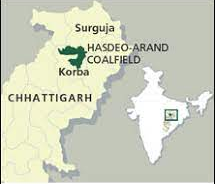Rajasthan Switch to Hindi
Rajasthan Questions Findings on Parsa Mine Clearance
Why in News?
Recently, Rajasthan Rajya Vidyut Utpadan Nigam Limited (RRVUNL) has questioned the legitimacy of a report by the Chhattisgarh State Scheduled Tribes Commission (CSSTC), which found irregularities in environmental clearances for the Parsa coal mine in the State’s Surguja region.
- The Parsa coal block is located in the north central part of the Hasdo-Arand.
Key Points
- Earlier Findings:
- According to RRVUNL, in 2023 the CSSTC, set aside allegations regarding the Parsa mine following a detailed inquiry by the Surguja district administration.
- In 2024, The Commission recommended canceling forest clearances for the Parsa mine, alleging they were obtained using forged gram sabha consent documents.
- RRVUNL countered that the gram sabha approval issue is under judicial review, with no adverse court observations on alleged irregularities.
- Role of RRVUNL and Adani Group:
- The Parsa coal mine, allotted to RRVUNL, is developed and operated by the Adani Group, despite ongoing opposition from activists and sections of local communities.
- Legitimacy of the Report:
- RRVUNL questioned the Commission’s report, and stated that the report was based on inputs from a small group of individuals, despite the issue involving thousands of local stakeholders.
- About Chhattisgarh State Scheduled Tribes Commission:
- The Chhattisgarh government formed the Tribal Advisory Council to recommend policies related to Scheduled Tribes.
- The Chief Minister of Chhattisgarh is the Chairman of the Council, and the Minister of Tribal and Scheduled Caste Development Department is a member.
Hasdeo Arand Forest
- Hasdeo Arand, a sprawling forest in the northern part of Chhattisgarh is known for its biodiversity and its coal deposits.
- The forest falls under Korba, Sujapur and Surguja districts with significant tribal population.
- The Hasdeo river, a tributary of Mahanadi, flows through it.
- Hasdeo Arand is the largest un-fragmented forest in Central India consisting of pristine Sal (Shorea robusta) and teak forests.
- It is a noted migratory corridor and has a significant presence of elephants.










%20MPPCS%202025%20Desktop%20E.jpg)
%20MPPCS%202025%20Mobile%20E%20(1).jpg)










.png)
.png)











 PCS Parikshan
PCS Parikshan


